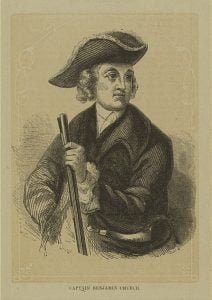War of 1700
When war was again declared, in May 1702, the old difficulties with the Indians were speedily renewed. Governor Dudley, of Massachusetts, endeavored to preserve peace with these tribes, and concluded a negotiation with many of their chiefs, at Casco, in June of the following year. This appears to have been a mere blind on the part of the savages, then, as ever, favorable to the French; for only a few weeks subsequent to the treaty, a simultaneous attack was made upon the eastern English settlements. Every thing fell before the enemy; houses were burned, property of every kind was destroyed or plundered, and one hundred and thirty of the inhabitants were slain or captured.
The news of the terrible calamities attendant on the destruction of Deerfield, in the winter of 17034, combined with what he had himself witnessed of Indian cruelties, incited Major Church to volunteer his further services against the enemy. His blood boiled within him, making such impulses on his mind that he forgot all former treatments, which were enough to hinder any man, especially the said Major Church, from doing any further service.” His offers were gladly accepted, and a very considerable force was put under his command, with a good supply of whale-boats, the necessity for which he had seen in former campaigns along the irregular and indented coast of Maine.
Church’s Last Campaign

This was the last military duty undertaken by the old soldier, and it was performed with his usual skill and energy. The Indian towns of Minas and Chignecto were taken, and the enemy was successfully engaged at other points. The most noted event of the expedition was the night attack at Passamaquoddy. In the midst of the con fusion incident to the marshalling of disorderly and undisciplined troops, an order was issued by Church for the destruction of a house, and of its inhabitants, who had refused to surrender. In his own words: “I hastily bid them pull it down, and knock them on the head, never asking whether they were French or Indians they being all enemies alike to me.” In a note to this transaction, Mr. Drake says: “It does not appear, from a long career of useful services, that Church was ever rash or cruel. From the extraordinary situation of his men, rendered doubly critical by the darkness of the night, and the almost certain intelligence that a great army of the enemy were at hand, is thought to be sufficient excuse for the measure.” The major, in his own account, adds: “I most certainly know that I was in an exceeding great passion, but not with those poor miserable enemies; for I took no notice of a half a dozen of the enemy, when at the same time I expected to be engaged with some hundreds of them. In this heat of action, every word that I then spoke I cannot give an account of; and I presume it is impossible.” Quarter was shown to all who came out and submitted, upon requisition.
War of 1722
From the close of the war, and the conclusion of peace with France, in 1713, until 1722, there was little to disturb the eastern frontier, further than some contentions between the colonists and Indians arising out of disputed titles to land. A Frenchman named Ralle, of the order of Jesuits, resided, in 1721, among the Indians at Norridgewock, and being suspected by the English of exerting a pernicious influence over his flock, a party was sent, by the Massachusetts government, to seize upon his person. Ralle escaped, and the undertaking only hastened hostilities.
Indian depredations soon commenced, and war was regularly declared by Massachusetts. For three years the frontier settlements suffered severely. The English succeeded in breaking up the principal head-quarters of the enemy, viz: at the Indian castle some distance up the Penobscot, and at the village of Norridgewock.
At the taking of the latter place, Ralle, with from fifty to a hundred of his Indian comrades, perished.
Captain John Lovewell

One of the most noted among the English campaigners during this war was the famous Captain John Lovewell, of Dunstable. His adventures, and particularly the fight at Pigwacket, on the Saco, in which he lost his life, were widely celebrated in the rude verse of the times.
This engagement was the last important event of the war; the Indians were greatly reduced in numbers, and, when no longer stimulated and supported by the French, were incapable of any systematic warlike operations.
